Physical Address
304 North Cardinal St.
Dorchester Center, MA 02124
Fine-needle aspiration (FNA) of the kidney is a useful technique for the diagnosis of selected renal lesions. FNA, as it turns out, is not necessary for most renal masses. In adults, the great majority of renal lesions are either radiologically benign cysts requiring no treatment or radiologically malignant masses for which FNA is redundant. Cross-sectional imaging such as ultrasonography (US), computed tomography (CT), and magnetic resonance imaging (MRI) are remarkably accurate in diagnosing most benign cysts and renal cell carcinomas (RCCs). Thus only a small percentage of adult renal lesions, perhaps less than 10%, are candidates for biopsy to further define patient management, although this number may grow as interest in the active surveillance of patients with renal masses increases.
Numerous studies have compared renal FNA with core needle biopsy. Not surprisingly, core needle biopsy, which allows architectural assessment more readily, is more sensitive and thus preferred by the American Urologic Association. The combination of core needle biopsy and FNA, however, is more sensitive and accurate than either test alone, and the addition of FNA to a patient already undergoing core needle biopsy, although increasing procedural time, does not add significant risk to the patient or much more cost. In our experience, approximately 5% to 10% of patients who undergo both procedures have diagnostic material only on the FNA sample and are thus spared the additional expense and risk associated with a repeat biopsy if only a core had been done. Others report similar results. The added yield of an FNA may be particularly true of small lesions. For this reason, we recommend an FNA and a core needle biopsy whenever possible. Of note, radiologists may prefer to perform an FNA alone (without core needle biopsy) of certain masses because of the perceived risk of hemorrhage based on their imaging features and location.
Radical nephrectomy is contraindicated
Probable advanced-stage (unresectable) renal cell carcinoma
Possible metastasis to the kidney (e.g., history of lung cancer)
Patient has coincident medical problems
Patient desires an investigational treatment
Radiologic findings are equivocal
Atypical cyst
Small solid mass (“low-fat” angiomyolipoma vs oncocytoma vs RCC)
A partial nephrectomy is considered
Small lesion, young patient, or both
Decreased renal function
Active surveillance is being considered
An infection (pyelonephritis or abscess) is suspected
Radiographically guided ablation but diagnosis needed
Renal FNA is indicated in the six settings described above. For a patient who is not a candidate for nephrectomy, FNA provides the easiest method to obtain a diagnosis. A mass might be unresectable for a variety of reasons: (1) based on imaging features, it is probably an advanced-stage RCC; (2) there is a history or suspicion of a primary malignancy elsewhere, and the kidney mass might be a metastasis; or (3) the patient is a poor operative risk because of a comorbid condition. A benign FNA diagnosis (e.g., oncocytoma, angiomyolipoma) would avoid unnecessary surgery in such a high-risk patient.
Some patients have a radiographically indeterminate lesion. These include atypical cysts and small, homogeneously enhancing masses. By definition, atypical, radiologically indeterminate cysts contain more than a few septations, thickened septae, thick walls, or non-border-forming calcifications. Extensive histologic sampling is needed before one can conclude that an atypical cyst is benign. This significantly limits the utility of FNA in this setting. Still, FNA is sometimes performed, even though the results need to be viewed with some skepticism (see “Renal Cysts”). Small, homogeneously enhancing renal masses are also difficult to classify as benign or malignant by imaging studies alone. Many turn out to be angiomyolipomas with little or no fat content, but some are small RCCs. Because angiomyolipoma can be reliably distinguished from RCC by FNA in most cases, FNA plays an important role in the evaluation of small, homogeneously enhancing renal masses.
Some carcinoma subtypes, namely chromophobe RCC, clear cell papillary RCC, and mucinous tubular and spindle cell carcinoma, have a good prognosis and are amenable to treatment by partial nephrectomy. This operation is increasingly common as the incidence of smaller lesions and lesions in younger patients increases. Patients with von Hippel–Lindau (VHL) syndrome, who are at risk for multiple and bilateral tumors, and those with decreased renal function are also candidates for nephron-sparing surgery. Although the ultimate decision to treat by partial nephrectomy depends on the size and location of the lesion, as well as other clinical factors, FNA is valuable because it discloses whether the tumor is one of the good-prognosis neoplasms more appropriately treated by partial nephrectomy. Biopsy results are also valuable for counseling a patient who is considering active surveillance, which is more appropriate for someone with a tumor that has no adverse findings (high grade, sarcomatoid features, geographic necrosis, etc).
In the patient with focal bacterial pyelonephritis or a renal abscess, needle placement permits both diagnosis and therapeutic drainage. These lesions can appear mass-like and mimic a renal tumor. Signs and symptoms of a urinary tract infection are usually present, and thus most renal infections can be diagnosed clinically, without the need for an FNA. Some renal infections are clinically subtle, however. Imaging findings sometimes help in the distinction from a neoplasm: pyelonephritis with abscess formation tends to have ill-defined margins and perinephric stranding. If, after clinical and radiographic assessment there is still doubt, FNA can be useful to confirm infection and exclude malignancy.
Finally, radiologists are increasingly using a wide variety of ablation techniques, including radiofrequency, thermal, and chemical ablation, to eradicate renal masses. With strict patient selection, especially with regard to tumor size, ablation can be definitive treatment for a patient who is not a candidate for surgery. Although not always performed, it is advantageous to obtain a specimen before the lesion is ablated for definitive diagnosis, prognosis, and comparison should the patient develop a lesion that may represent a metastasis or recurrence.
Virtually all renal aspirations are performed percutaneously by radiologists using US, CT, or MRI for guidance. Rarely, the FNA is performed endoscopically with US guidance or during surgery. Complications are uncommon and include bleeding, hematuria, pneumothorax, infection, arteriovenous fistula, and urinoma. Needle track seeding is extremely rare with the use of small (less than 18-gauge) needles ; there have been fewer than 10 reported cases of needle track seeding associated with a renal mass FNA, for an estimated incidence of less than 0.01%. Whether the increased use of core needle biopsy will have the same results is not yet known.
Slides are air-dried and stained with a Romanowsky stain or alcohol-fixed and stained with the Papanicolaou or hematoxylin and eosin stains. Cell blocks are particularly helpful for identifying architectural features like papillae and provide an ideal platform for immunocytochemical studies (e.g., HMB-45 to confirm the diagnosis of an angiomyolipoma; Table 15.1 ). Agar-embedded microbiopsy specimens may help to improve diagnostic yield. Some tumors, including some clear cell RCCs, are so tightly cohesive that they are almost impossible to aspirate, yet straightforward to interpret given a tissue core or cell block material. Conversely, with scant material (insufficient for immunohistochemistry [IHC]), it is often easier to make a diagnosis with a smear as opposed to a core biopsy.
| Diagnosis | Usual Result | |
|---|---|---|
| Positive | Negative | |
| Angiomyolipoma | HMB-45, MelanA | keratins, PAX8, S100 |
| Metanephric adenoma | WT1, BRAF V600E, cadherin 17, CD57 | EMA, CK7, AMACR |
| Wilms tumor | WT1 | EMA, cadherin 17, CD57 |
| Xanthogranulomatous pyelonephritis | CD68 | keratins, EMA |
| Clear cell RCC | PAX8, CD10, EMA, CAIX, AE1/AE3, CAM5.2, AMACR | CK7, CK20, CD117 |
| Papillary RCC | PAX8, EMA, AE1/AE3, CAM5.2, CK7, AMACR, CD10 | WT1, CAIX, CD117 |
| Oncocytic papillary RCC | PAX8, GATA3 | CAIX |
| Oncocytoma | CD117, S100a1 | Hale’s colloidal iron, CK7, CK20, AMACR, CD10 |
| Chromophobe RCC | Hales colloidal iron, CK7, CK20, PAX8, CD117 | AMACR, CD10, S100a1, HNF1β |
| Succinate dehydrogenase-deficient RCC | PAX8 | SDHB (lost), CD117, CK7 |
| Clear cell papillary RCC | PAX8, GATA3, CK7, 34βE12, CAIX (cup-shaped) | AMACR, CD10 |
| Tubulocystic RCC | CK7, PAX8, AMACR, CD10 | CK20 |
| Renal medullary carcinoma | PAX8, OCT3/4, CK7, CAM5.2, CEA, 34BE12 | INI1 (lost) |
| Collecting duct carcinoma | 34βE12, CK7, PAX8 | OCT3/4 |
| MiT family translocation RCC | TFE3, PAX8, CAIX, cathepsin K, AMACR |
cytokeratins, EMA, CK7 |
| Mucinous tubular and spindle cell carcinoma | CK7, PAX8, AMACR, EMA | CD10, CAIX, GATA3, p63 |
| Urothelial carcinoma | GATA3, CK7, CK20, p63 | PAX8 |
| Adrenal cortical neoplasms | inhibin, calretinin, MelanA, SF1 | PAX8, keratins |
| Pheochromocytoma | chromogranin, synaptophysin, S100 (sustentacular cells only) | keratins, SF1 |
Cytogenetics and molecular cytogenetics are useful adjuncts, particularly in subtyping RCCs. A karyotype can be obtained from short-term culture of fresh, needle-rinse fluid. Fluorescence in situ hybridization (FISH) can be performed on unstained cytospins, thinlayers, smears, and cell block sections.
Historically, renal FNA has accurately distinguished benign from malignant lesions in 73% to 94% of cases, but a cytologist should be able to make this distinction in greater than 90% of cases. Adequacy correlates more strongly with the nature of the lesion than the number of passes performed ; some tumors are particularly resistant to adequate aspiration, either because the lesional cells are scant or because they are difficult to extract from surrounding stroma. Correct subclassification of RCC by cytomorphology is achieved in 74% to 80% of cases, and in up to 90% of cases for the most common subtypes of RCC. Accuracy increases to 99% for the most common subtypes of RCC by using cores and IHC for carbonic anhydrase IX (CAIX), CD117, AMACR, CK7, and CD10. Unfortunately, there is still no immunohistochemical stain specific for oncocytoma, making this a diagnosis of exclusion and one that is less reliable than a diagnosis of RCC.
Because kidney FNAs are relatively uncommon, it can be difficult for some to obtain expertise in this area. False-positive results occur when xanthogranulomatous pyelonephritis, angiomyolipoma, benign hepatocytes, tubular cells, glomeruli, urothelial cells, or adrenal cortical cells are misinterpreted as a malignancy. Cellularity is important to consider when interpreting a kidney FNA; benign mimics of malignancy can contain atypical cells, but they are usually few in number or the sample itself is hypocellular. Most hypocellular kidney aspirates therefore should not be diagnosed as positive even if they contain some atypical cells.
Up to 30% of renal aspirates are nondiagnostic (inadequate); a repeat aspiration is helpful in approximately one-half of cases. With some lesions (cystic nephroma, cysts, etc.), it is difficult to obtain representative cells, either because the cells are rare or because they are embedded in stroma. Although there is no consensus on adequacy criteria, it is reasonable to consider a renal FNA specimen adequate if a specific (benign or malignant) diagnosis can be made or if there is sufficient cellularity to suggest a limited differential diagnosis. A specimen composed exclusively of macrophages (typically from a cystic lesion) is best reported as nondiagnostic rather than negative because, unless it is a radiographically benign cyst, a cystic RCC cannot be excluded (see “Renal Cysts”).
Large, dense, globular structures
Capillary loops
Papillary RCC
Round nucleus
Visible nucleolus
Abundant granular cytoplasm
Oncocytoma
Chromophobe RCC
Round nucleus
Scant to moderate amount of cytoplasm
Low-grade clear cell or papillary RCC
Normal elements are occasionally encountered, particularly when the radiologist is sampling a small lesion and the needle excursions traverse normal kidney. It is vital not to misinterpret normal elements as tumor cells. Glomeruli ( Fig. 15.1A and B ) are highly cellular globular structures that mimic the papillae of papillary RCC, especially at low magnification. Glomeruli lack atypia, but so do low-grade papillary RCCs. In contrast to papillary RCC, however, the cells in a glomerulus are not evenly distributed, but instead are much more dense in the center than at the periphery; most importantly, close inspection of the edges of a glomerulus reveals its distinctive capillary loops.
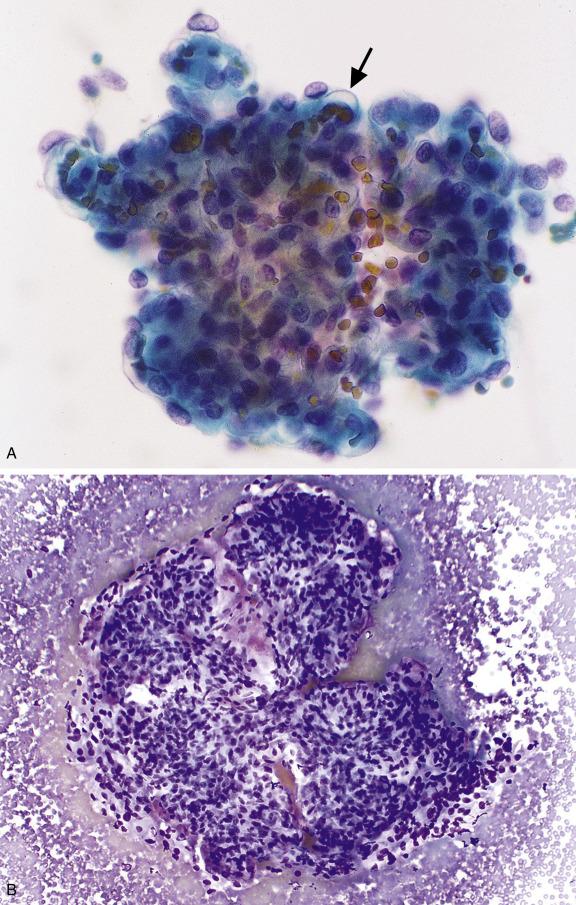
Proximal tubular cells have a round, bland nucleus, a small but easily seen nucleolus (with alcohol-fixed preparations), and abundant, granular cytoplasm ( Fig. 15.2A and B ). The cells lack a well-defined cell border, and the granules often appear to be spilling out of the cells. They are very similar to the cells of an oncocytoma and chromophobe RCC. FNAs of both tumors, however, are usually more cellular and their cells are frequently binucleate, often with some variation in cell and nuclear size and shape. Also, the cell borders of an oncocytoma and chromophobe RCC are usually sharply defined, whereas those of proximal tubular cells are torn and irregular.

Distal tubular cells are small, isolated or cohesive cells, with less cytoplasm than proximal tubular cells ( Fig. 15.3A and B ). Their cytoplasm is clear to slightly granular, and they have a small, round nucleus and an inconspicuous nucleolus. The cell borders are well defined, and the cytoplasm is not vacuolated. Distal tubular cells are very similar to the malignant cells of a low-grade clear cell or papillary RCC. Aspirates of those tumors are usually more cellular, however, and the cells of low-grade papillary RCC form papillae and spherules, something distal tubular cells do not.

Oncocytoma, a benign tumor of oncocytes (cells with abundant granular cytoplasm), comprises 5% to 9% of all renal tumors. They have a wide age distribution, and most are incidental findings in patients undergoing imaging studies for unrelated reasons. Radiologic findings cannot be relied upon to make a confident diagnosis of oncocytoma. Histologically, tumor cells have abundant granular cytoplasm and uniform round nuclei, with small but distinct nucleoli equivalent to those of a World Health Organization/International Society of Urological Pathology (WHO/ISUP) grade 2. Occasional cases contain scattered large, sometimes bizarre nuclei, but mitoses are absent or very rare. Electron microscopy reveals abundant mitochondria, which account for the characteristically granular cytoplasm by light microscopy. The arrangement of the neoplastic cells in solid, rounded nests is distinctive and contrasts with the trabeculae (ribbons) of a chromophobe RCC. The most common cytogenetic abnormalities are losses of chromosomes 1 and Y, but deletions, rearrangements, and even a normal karyotype also occur. Recent studies have shown that oncocytomas are associated with complex I enzyme deficiency and mutations of mitochondrial DNA, but the specificity of these findings remains to be defined. At present, there is no reliable “positive” ancillary test for oncocytoma, and the diagnosis remains one of exclusion.
Highly cellular
Rounded nests (cell block or core)
Cohesive fragments and dispersed cells (smears)
Abundant uniformly granular cytoplasm
“WHO/ISUP grade 2” nucleoli
Cytologically, smears from a well-sampled oncocytoma reveal numerous isolated cells with abundant, eosinophilic, granular cytoplasm, well-demarcated cell borders, and a round nucleus with a small or medium-sized nucleolus ( Fig. 15.4A and B ). In occasional cases, isolated pleomorphic or bizarre nuclei occur and can be quite alarming, but these are thought to represent degenerative changes and are not indicative of malignancy. Necrosis is absent, and mitoses are either absent or very infrequent. Atypical mitoses are not seen. Cytoplasmic hyaline globules have also been reported, but these are not specific and may be more common in other tumors with granular cytoplasm such as succinate dehydrogenase-deficient RCC.
Hepatocytes
Clear cell RCC
Papillary RCC
Chromophobe RCC
Tubulocystic RCC
Succinate dehydrogenase–deficient RCC
Hereditary leiomyomatosis RCC
Birt-Hogg-Dube syndrome tumors

When examining cells with abundant granular cytoplasm, one should consider inadvertent sampling of the liver, which happens with FNAs of a right renal mass if the needle traverses the liver on its way to the kidney. Hepatocytes have abundant granular cytoplasm, but they often contain lipofuscin pigment and show more variation in nuclear and cellular size (see Fig. 13.1 ). If hepatocytes are the only finding, the sample is nondiagnostic (insufficient).
One also needs to exclude RCC. Many RCC subtypes have granular cytoplasm and thus mimic an oncocytoma. Some clear cell RCCs are comprised mostly of granular (rather than clear) cytoplasm. In comparison to the cells of an oncocytoma, those of a clear cell RCC are more cohesive, usually with more nuclear atypia and less uniformly granular cytoplasm. The rare oncocytic variant of papillary RCC resembles an oncocytoma with smear preparations, but a cell block and core biopsies demonstrate the characteristic papillae. In addition, the cells of the oncocytic variant of papillary RCC are diffusely positive for GATA3; oncocytomas are negative. The cells of chromophobe RCCs have abundant granular cytoplasm, but it is usually less uniformly granular (there is often a patchy, perinuclear clearing), and they may have greater nuclear outline irregularity. Nucleoli are uncommon in chromophobe RCC, whereas small nucleoli are often seen in oncocytomas. Nevertheless, in any individual case the distinction between a chromophobe RCC and an oncocytoma can be extremely difficult on smear preparations alone. Tissue fragments in cell block sections, fortunately, are tremendously helpful: the cells of an oncocytoma are arranged in solid round nests (you can draw a circle around them) ( Fig. 15.4C ), whereas the cells of a chromophobe RCC are in endless trabeculae. The Hale’s colloidal iron stain is helpful (in laboratories that perform it reliably) because it usually shows diffuse cytoplasmic staining in chromophobe RCCs, and most oncocytomas are negative or only focally positive in a luminal pattern ( Fig. 15.4D ). Immunohistochemical markers (CD117, CK7, CK20, among others) are also helpful in the distinction between oncocytoma (positive for CD117, negative or only focally positive for CK7 and CK20), chromophobe RCC (positive for CD117 and diffusely positive for CK7 and CK20), and clear cell RCC (negative for CD117).
Less-common tumors should be considered. The cells of tubulocystic RCC have abundant granular cytoplasm, but they tend to be arranged as tubules or flat sheets with spaces (“windows”) between cells rather than as individual cells. Rare hybrid renal tumors comprised of oncocytoma and chromophobe RCC do occur, either sporadically or in association with the Birt-Hogg-Dube syndrome ; FNA findings depend on the areas sampled. One study suggests that oncocytomas have abnormalities of mitochondrial DNA that are not present in either chromophobe RCC or hybrid tumors. The cells of hereditary leiomyomatosis RCC have a characteristic “cytomegalovirus (CMV)-like nucleolus,” which is not seen in oncocytomas. Succinate dehydrogenase-deficient RCC has abundant granular cytoplasm but appears to have unique cytoplasmic inclusions and is negative for CD117 and shows loss of SDHB by IHC.
Whether a definitive diagnosis of oncocytoma can and should be made by FNA (with or without core biopsy) remains controversial. Only 65% of surveyed genitourinary pathologists say they will make the diagnosis of oncocytoma on a core needle biopsy. Nevertheless, some centers, including ours, routinely make this diagnosis, but with the following caveats. A definitive diagnosis of oncocytoma is especially helpful in patients who are poor surgical candidates, for example, the elderly with comorbidities. In that setting, with a cell block or core biopsy that demonstrates the characteristic architecture and staining pattern (negative for Hale’s colloidal iron; positive for CD117; negative or only focally positive for CK7 and CK20), a diagnosis of oncocytoma can be rendered. In a younger patient, an oncocytic lesion should be resected if possible, and the diagnosis “Oncocytic Neoplasm (oncocytoma vs RCC, especially chromophobe RCC)” is more appropriate. For an elderly patient whose FNA lacks a cell block, the appropriate diagnosis is also “Oncocytic Neoplasm (oncocytoma vs RCC, especially chromophobe RCC).” It is unwise to make a definitive diagnosis of oncocytoma without an assessment of tissue architecture by cell block or core biopsy because virtually all the other features of oncocytoma are mimicked by many RCC subtypes, not just the chromophobe RCC.
Except for their size, papillary adenomas are histologically, immunohistochemically, and cytogenetically indistinguishable from low-grade papillary RCCs. In the most recent classification system of renal tumors, the maximum size allowed for a papillary adenoma was increased from 0.5 cm to 1.5cm. As a result, whenever one is considering the diagnosis of papillary RCC, one should inquire about the size of the lesion. If the radiologist has sampled a nodule smaller than 1.5 cm, one should add papillary adenoma to the differential diagnosis.
Angiomyolipomas (AMLs) are benign mesenchymal tumors that arise from perivascular epithelioid cells and comprise 1% of all surgically excised renal tumors. They occur in two distinct clinical settings. Approximately one-half occur in young adults with tuberous sclerosis (TS), an autosomal dominant disease caused by mutation of one of the two TS-associated genes and manifested by mental retardation, seizures, and skin changes. In patients with TS, the AMLs are usually multiple and bilateral. The other half are usually solitary and occur in young and middle-aged women with no known clinical syndrome. Some patients present with flank pain, but most AMLs are detected incidentally during a radiologic workup for an unrelated disorder. They range widely in size and can be tiny or up to 20 cm in diameter. Large lesions can bleed, and some are resected to prevent this from occurring.
Histologically, an AML is composed of three elements: mature fat, blood vessels, and atypical smooth-muscle-like perivascular cells; the latter can have moderate-to-marked atypia. Mature fat makes up the bulk of most AMLs, but these common, fatty AMLs are reliably identified by imaging studies, precluding the need for an FNA, except perhaps when well-differentiated liposarcoma is a consideration based on imaging findings. FNA is needed only for the subset of AMLs that have very little adipose tissue (the “fat-free” or “low-fat” AMLs), which cannot be distinguished from a RCC by imaging alone. In virtually all cases, the neoplastic cells, most conspicuously the atypical smooth muscle-like perivascular cells but also the lipid-distended fat cells, are immunoreactive for melanoma-related antigens like HMB-45 and MART-1 (Melan-A). An uncommon subtype, the epithelioid AML, is composed of large epithelioid (rather than spindle) smooth muscle cells. Epithelioid AMLs have metastatic potential, but predicting which will behave in a malignant fashion is problematic.
Spindled cells (± nuclear atypia) with stringy cytoplasm
Fat cells
Intracytoplasmic vacuoles
“Endocrine-type” nuclear atypia
Thick-walled blood vessels (rare)
Epithelioid cells with marked atypia (“epithelioid angiomyolipoma”)
AMLs can be diagnosed confidently by FNA, but they have their challenges: specimens are usually paucicellular; the adipose tissue component is scant or nowhere to be found; and the thick vessels are rarely seen. The atypical smooth muscle-like perivascular cells, sometimes with moderate-to-marked nuclear atypia, usually dominate the picture ( Fig. 15.5A–C ). Atypical spindle cells and their very large nuclei, if present, are usually interspersed among numerous much less atypical cells. The evenly granular chromatin and the mixture of very large and smaller nuclei recalls the “neuroendocrine-type” atypia of some benign neuroendocrine lesions. The cytoplasm of the smooth muscle cells has a stringy or crystalline appearance, quite different from the vacuolated or granular cytoplasm of RCC. Scattered large, clear fat vacuoles can be present and impart a resemblance to the clear cell component of clear cell RCC. The differential diagnosis includes RCC, typical and sarcomatoid types, and sarcoma. Immunostains for HMB-45 and MART-1 (Melan-A) are extremely helpful because RCCs and most sarcomas are negative for these markers ( Fig. 15.5D ).
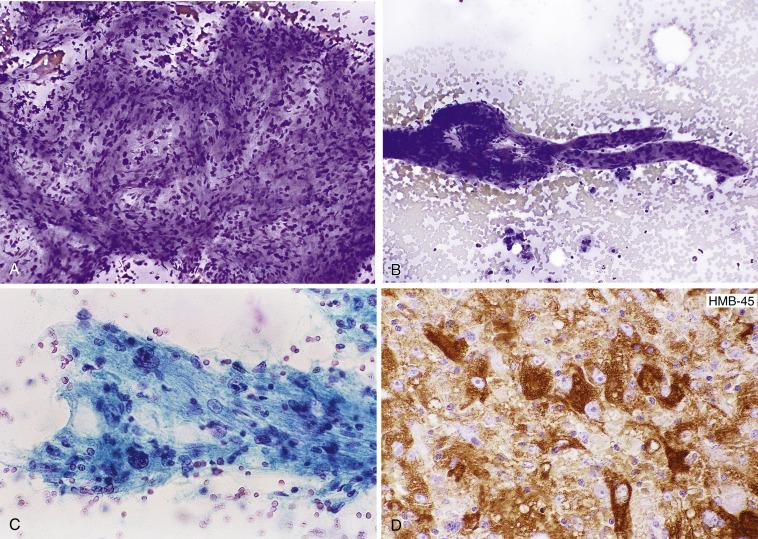
The cells of an epithelioid AML are round and range from medium-sized to huge; because of their abundant cytoplasm and enormous nucleoli, they resemble ganglion cells. Necrosis and mitoses can be seen. The differential diagnosis of an epithelioid AML includes clear cell RCC. Here, too, immunostains are extremely helpful in distinguishing an epithelioid AML from RCC.
Of note, AML is one of the lesions most likely to yield a sparsely cellular, difficult-to-interpret sample composed of rare spindle-shaped cells and stromal fragments. Nevertheless, it is often possible to demonstrate immunoreactivity for HMB-45 and make a definitive diagnosis on this basis. For this reason, it is prudent to obtain immunostains on any atypical or paucicellular spindle-cell or epithelioid-cell lesion in the kidney.
Metanephric adenoma (MA) is a rare, essentially benign kidney tumor, although the occasional case with metastases has been described. It can be found in men and women at any age but most commonly occurs in women in the fifth and sixth decades. About one-half are discovered incidentally; the rest are detected because of hematuria, flank pain, or polycythemia. They range from small to very large lesions and can measure up to 15 cm in diameter. Histologically, MA is composed of tight, uniform tubules lined by bland cells with a small round nucleus and inconspicuous nucleolus. Mitoses are absent or very infrequent. Psammoma bodies are common. MAs resemble low-grade papillary RCCs and differentiated Wilms tumors. Unlike papillary RCC, they are negative for epithelial membrane antigen (EMA), cytokeratin 7, and AMACR, and they have a normal karyotype. Like Wilms tumor, MAs show nuclear immunoreactivity for WT1. Cadherin 17 is very specific and CD57 relatively specific for MA; these immunostains help in the distinction from Wilms tumor. A BRAF V600E mutation is present in nearly 90% of MAs and can be detected by IHC with a mutation-specific antibody. Because RCCs are virtually never positive for BRAF V600E by IHC, this can be very helpful for diagnosis. For cases that do not have the expected immunophenotype (negative for EMA, cytokeratin 7, and AMACR; positive for cadherin 17, WT1, CD57, and BRAF V600E), FISH may be useful in distinguishing MA from papillary RCC.
Tight cell clusters or sheets
Small cells
Scant cytoplasm
Round, uniform nucleus
Small nucleolus
On cytologic preparations, the cells form short tubules, tight balls, and loose sheets; they have scant cytoplasm; a round nucleus with fine, even chromatin; and a rare small nucleolus ( Fig. 15.6A–C ).
Differentiated, epithelial-predominant Wilms tumor
Low-grade papillary RCC
Metastatic tumor
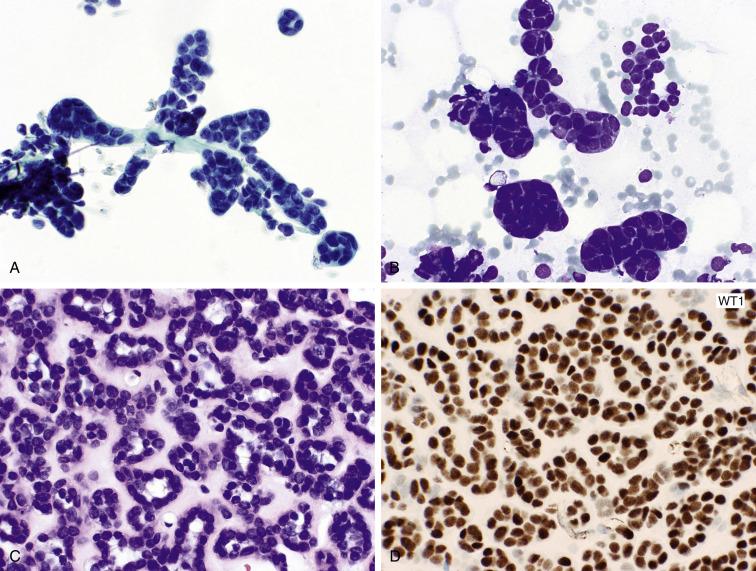
Most Wilms tumors are easily distinguished from MA because Wilms tumors are triphasic neoplasms that contain a blastemal component (small, closely packed, mitotically active cells) as one of their three constituents ( Fig. 15.7A-D ). An epithelial-predominant Wilms tumor, with little or no blastema, can be virtually impossible to distinguish from MA, but the cells of a Wilms tumor may be larger, with more hyperchromasia and mitoses. MAs are positive for cadherin 17 and CD57, whereas Wilms tumors are negative for cadherin 17 and usually (though not always) negative for CD57. Low-grade papillary RCCs have more cytoplasm than MA and, unlike MA, are positive for EMA and cytokeratin 7 and negative for WT-1 and BRAF V600E. Finally, because of the high nuclear-to-cytoplasmic ratio of MA cells, a metastasis should be considered. Most metastases are EMA-positive, and a metastasis is unlikely in the absence of a known or suspected primary tumor elsewhere.
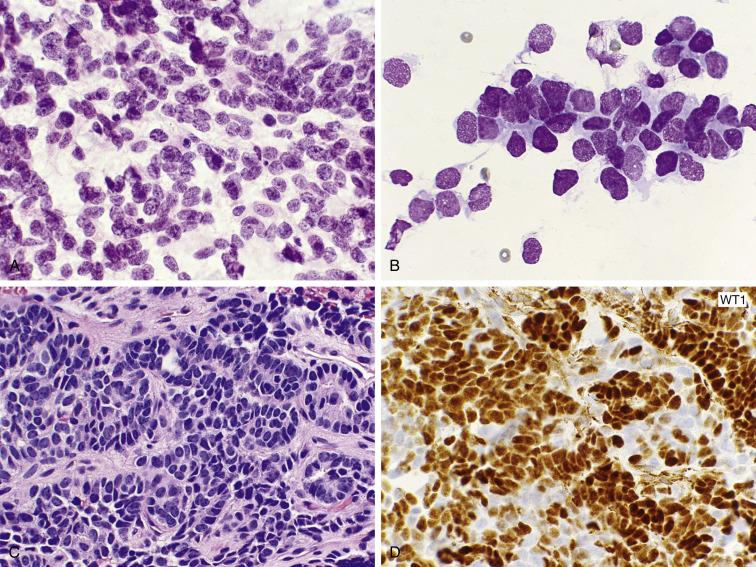
The mixed epithelial and stromal tumor (MEST) family encompasses a spectrum of cytologically indistinguishable tumors that range from those that are predominantly cystic (adult cystic nephroma) to tumors with prominent solid components. MEST occurs most often as a solitary tumor in peri-menopausal women. Imaging studies often show an enhancing solid component and thus may raise the possibility of malignancy. MEST is composed of stroma and cysts lined by atypical epithelium. Pediatric cystic nephroma, which usually occurs in children below the age of 24 months, is considered a distinct entity. Pediatric cystic nephroma is usually negative for inhibin and harbors DICER1 mutations, whereas adult lesions are usually at least focally positive for inhibin and rarely have DICER1 mutations. The stroma in both lesions is typically reactive for estrogen and progesterone receptor.
FNAs are usually misdiagnosed as either RCC, AML, or sarcoma. Specimens are generally sparsely cellular but contain some epithelial cells with granular or vacuolated cytoplasm, nuclear membrane irregularity, and prominent nucleoli ( Fig. 15.8A–C ). Alternatively, specimens consist of large, pleomorphic spindle cells, admixed with cells with intracytoplasmic vacuoles simulating fat. Core biopsy specimens help show the interrelationship between the glandular and stromal components (see Fig. 15.8B ), and IHC can demonstrate the immunoreactivity of the stromal cells for estrogen and progesterone receptors ( Fig. 15.8D ). As a rule, complete excision is required to make a definitive diagnosis. The only predictable cytologic feature is sparse cellularity, although samples prepared using concentration methods (e.g., ThinPrep, SurePath) may appear more cellular. This adds support to the wisdom that hypocellular specimens with atypical cells should not be reported as positive for malignancy.
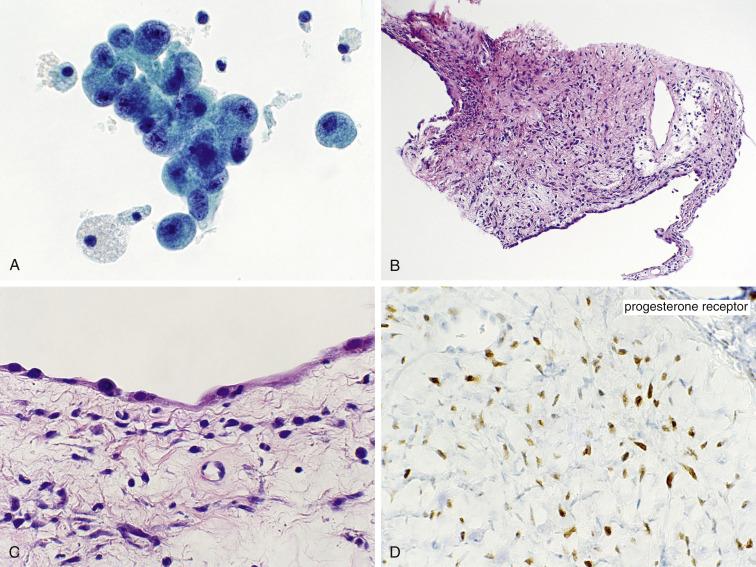
Focal bacterial pyelonephritis and a renal abscess can appear mass-like radiologically. Aspirates contain necrotic material and numerous neutrophils, sometimes with rare atypical cells that are easily confused with those of a clear cell RCC. The atypical cells are few in number, however, and in the context of abundant acute inflammation should be reported (at most) as suspicious for malignancy.
Tuberculous pyelonephritis has been reported in children, and a diagnosis has been made on FNA. The lesion shows acute and granulomatous inflammation. The differential includes other infections and xanthogranulomatous pyelonephritis. Culture remains the best method for a definitive diagnosis.
Become a Clinical Tree membership for Full access and enjoy Unlimited articles
If you are a member. Log in here